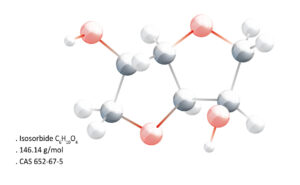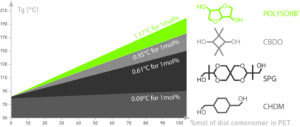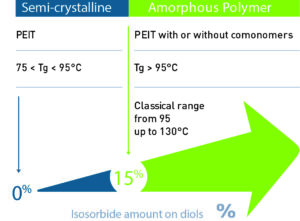Cosmetics & Personal Care
A new packaging solution for aerosols 10th November 2020
Plastics packaging enables suppliers of aerosol products to break free of the design and performance constraints of aluminium and steel: next-generation plastics can provide an ideal solution for personal care and household products.
In 2019, the global aerosol market was valued at $86 billion and it is estimated to see a CAGR of 6.6% over the next seven years, largely within the personal care sector.1 Aluminium and steel dominate in aerosol packaging, but what about plastic? New polymers offer compelling attractions when it comes to design flexibility, core performance and environmental impact. Poly(ethylene-co-isosorbide) terephthalate (PEIT), a modified form of polyethylene terephthalate (PET) containing isosorbide (Figure 1), a renewable feedstock for high-performance materials, offers exciting possibilities for aerosol packaging and is just beginning to penetrate the market.

Fig. 1
Why switch from metal to plastic?
The use of plastic packaging for aerosols is growing, and there are good reasons why it should. A switch to plastic addresses primary limitations such as:
- Corrosion – plastics offer greater chemical resistance, no rusting at the base, and enable water-based formulation, potentially providing access to new markets.
- Weight – plastics enable lighter weight designs, a major advantage with respect to transport that also reduces the risk of damage from a dropped product.
- Design flexibility – plastics provide opportunities for packaging that are softer, warm to touch and/or transparent, and that realize unconventional or ergonomically superior shapes with enhanced customer appeal.
- Safety – plastics eliminate the risk of explosion due to over-pressure, allowing safe storage in the sun and reducing the risks associated with full pallet storage.
“Whether you’re the end user or a supplier, elimination of the risk of explosion is a major gain with plastic aerosols. They can be stored safely in the sun or in a car and the worst-case scenario with a full pallet is a fire, rather than a potentially energetic explosion,” states Dr René Saint-Loup, Performance Materials and Cosmetic ingredients Technical Team Manager at Roquette.
When it comes to manufacturing efficiency and economics, plastic can also be highly competitive, with lower costs and the possibility of ‘just-in-time’ production adjacent to the filling line. In Europe, the Aerosol Dispensing Directive (ADD)2 currently limits the volume of plastic aerosols to 220 ml, but these guidelines were written in 1975 and are due to be updated in 2020. Advances in plastics increase the likelihood of a substantial revision, with modern materials well-suited to the demands of aerosol packaging.
What is PEIT?
PET is the world’s most used polymer, particularly for packaging and synthetic fibres, and is the preferred packaging material for aerosols. Indeed, a collaborative special industry group established by Petcore Europe and the European Aerosols Association (FEA) is already focusing on how best to handle an anticipated rise in PET aerosols in the household waste stream the over coming years.3 PET recycling – both mechanical and chemical – is well-established.
PET is a copolymer of ethylene glycol and terephthalic acid. The manufacture of PEIT additionally incorporates isosorbide as a third monomer via the bulk polymerization of ethylene glycol, terephthalic acid and isosorbide. While ethylene glycol and terephthalic acid are still mainly derived from petrochemicals, isosorbide is a plant-derived monomer, produced from annually renewable feedstocks. Plant-based starches are hydrolyzed to glucose, which is converted to sorbitol, which is subsequently converted to isosorbide by hydrogenation (Figure 2).

Figure 2. Isosorbide is made by initially hydrolyzing plant-based starches to glucose, which is then converted to sorbitol, which is subsequently hydrogenated to form the desired isosorbide product.
Over the past couple of decades, companies such as Roquette (based in Lestrem, France), a leader in isosorbide production and supply, have refined isosorbide processing technology to the point of industrial-scale manufacture. Roquette operates the world’s first industrial-scale plant supplying high-quality and highly stable material. Sustainable, non-toxic and available in different grades, with one tailored specifically to the requirements of the polyester market, the resulting isosorbide has a very low carbon footprint of just 0.09 kg CO2/kg of product (as determined in an internal comparative study by Roquette based on life cycle analysis methodology and peer-reviewed by an external auditor). Thus, incorporating isosorbide into PET improves the environmental credentials of virgin polyester. Equally exciting is the potential isosorbide offers to enhance PET properties.
Properties of PEIT vs properties of PET
Isosorbide is:
- Non-toxic
- Non-endocrine disruptring
- Available at very high (>99.5%) purity
These characteristics make it suitable for food, cosmetics/personal care, and pharmaceutical applications. PEIT is a glass-like, heat-resistant, hot-fillable copolyester that can be used as either a recyclable or reusable plastic within these sectors. It offers high gloss, good optical properties, high impact resistance and enhanced chemical resistance.
However, the key characteristics driving interest in PEIT for aerosol packaging include a high glass transition temperature, Tg, and compatibility with existing PET recycling practices. The Tg of a polymer is a critical parameter since it defines the temperature above which the thermal properties of the material begin to change and more ‘rubbery’ behaviour is established; below their Tg, polymers are more glass-like. An important limitation of PET as an aerosol packaging material is that it does not have the thermal resistance required to meet the criteria laid out in FEA Standard 647.4 The incorporation of isosorbide directly addresses this limitation by increasing the Tg. It is more effective than any other alternative diol in this regard as well as being the only bio-based molecule. The result is a higher glass transition temperature with no loss of recyclability (Figure 3).

Figure 3. High-purity isosorbide increases the glass transition temperature, Tg, of speciality copolyesters more effectively than do alternative diols such as 2,2,4,4-tetramethyl-1,3-cyclobutanediol (CBDO), spiroglycol (SPG) or cyclohexanedimethanol (CHDM).
“The ability of isosorbide to increase the Tg of PET is critical for this application and it is more effective than any other replacement diol in this regard. Unlike PET, PEIT meets the thermal resistance requirements laid out in the FEA standards for aerosols – a major gain,” says Saint-Loup.
To obtain a Tg of ~90°C, as required for aerosol packaging, requires the incorporation of less than 15% isosorbide, ie, the substitution of less than 15% of the ethylene glycol in conventional PET. This means that the resulting PEIT is semicrystalline and can be mechanically recycled with existing PET waste streams. Recycled materials containing up to 50% modified PET fulfil all of the European PET Bottle Platform (EPBP) Testing Protocols for assessing PET recycling compatibility.5 PEIT can also carry the Resin Identification Code #1, as reserved for PET, based on the requirements of ASTM Standard 7611-7611M (Standard Practice for Coding Plastic Manufactured Articles for Resin Identification).6

Figure 4. Semi-crystalline PEIT meets the Tg specification for aerosol packaging and can be mechanically recycled into existing PET streams.
Looking ahead
Commercial products from companies such as Plastipak, Alpla and Airopack showcase the multiple benefits of switching from metal to PET aerosol packaging and illustrate what is already available. Lighter, lower-cost, and with a reduced carbon footprint, these solutions point to a bright future for plastic aerosols. Easily recycled through existing waste streams, they also offer distinctive features such as transparency. PEIT has the potential to further enhance the plastic aerosol product portfolio by providing better technical performance, notably a higher Tg, with no loss of recyclability. For those looking to exploit the growing demands for plastic aerosols, isosorbide is a high-performance monomer that demands a closer look.
For more information on high purity POLYSORB® isosorbide from Roquette, click here
REFERENCES
- Aerosol Market Size, Share & Trends Analysis Report By Application (Personal Care, Household, Automotive & Industrial, Foods, Paints), By Material, By Type, By region, And Segment Forecasts, 2020 – 2027. https://www.grandviewresearch.com/industry-analysis/aerosol-market.
- Directive 75/324/EEC – aerosol dispensers. Available to read at: https://osha.europa.eu/en/legislation/directives/40
- Plastic Aerosol Recycling Special Industry Group. https://www.petcore-europe.org/working-groups/plastic-aerosol-recycling-special-industry-group.html
- FEA Standard 647: Plastic Aerosol Dispensers – Technical Requirements. Available to download at: https://www.aerosol.org/mediaroom/fea-647-and-fea-650-are-now-available/
- “How we do a Recycling Evaluation !” https://www.epbp.org/page/5/layout-link-2-test-procedures
- ASTM D7611/D7611M – 20 Standard Practice for Coding Plastic Manufactured Articles for Resin Identification. Details and available to purchase: https://www.astm.org/Standards/D7611.htm



